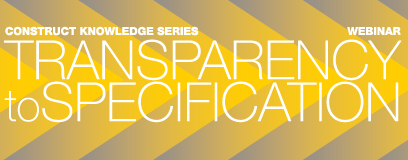
EPD-Webinar-Audio_1.mp3
Function: Construct Knowledge Series Spring Webinar
Listen to Part 1 of webinar from the download above
Watch Part 2 of webinar by clicking HERE
Transparency to Specification was a two-part Construct Knowledge Series webinar event covering how emerging trends such as Environmental Product Declarations (EPD) and Life Cycle Analysis (LCA) impact product specification.
The discussion featured perspectives and insights from a diverse group of industry professionals who are experts in their respective fields. In addition to EPD’s and LCA’s, the discussion also covered other topics such as green product certifications, the progression of LEED, carbon footprints, embodied energy and other topics impacting how products are specified.
Areas of discussion:
• Green product certifications
• How EPDs impact product specification.
• Which design phase are LCAs considered?
• Progression and impact of LEED
• Carbon footprints
• Embodied energy
• Objective product comparisons
• Greenwashing, ambiguous product claims
Noteable Quotes from Webinar:
Kate Simonen
“It [EPDs] will grow to be an accepted or expected parted of good industry performance.”
“EPDs and LCAs are really the international standard method of getting data and information from research to practice.”
“EPDs provide a more transparent and technically robust method of reporting a product’s environmental impact.
“Just because a product has an EPD doesn’t mean it is an environmentally preferable product. There is a lot of dialogue right now essentially alluding to the fact that if you have an EPD then you have a green product, and that not just the case. EPD is an equivalent of a nutrition label for food. Just because food has a nutrition label on it doesn’t mean it’s healthy for you. But if you read lots of nutrition labels you can understand that at certain times some foods are better for you than other times. There are many different criteria for nutrition labels just like there are many different criteria on an EPD. “
Derrick Teal
“I think the whole point of getting an EPD is to show you don’t really have anything to hide.”
“I think that once LEAD v4 is introduced you’ll see a lot more EPDs being specified or products of EPDs being specified…”
Heather Gadonniex
“Having an EPD at this point, particularly in North America, really demonstrates true sustainability leadership.”
“They [EPDs] are easy to understand and they are credible, which I think adds a lot to the validity of the tool.”
“If you are looking at product literature, there is no guarantee that those claims are third party verified. But if you have an EPD, there is essentially a seal of approval saying, ‘OK, this document has been reviewed by a third party program operator.’ Not only has the LCA been verified, but the actual content of the EPD has also be verified against the product category rules.”
“The end user of the EPD encourages the use of more environmentally friendly and sustainable products, ultimately driving product development, innovation and the manufacturing process.”
Francesca Desmarais
“Without an EPD, architects and specifiers are in the dark about the comprehensive environmental and health impact of that product.”
